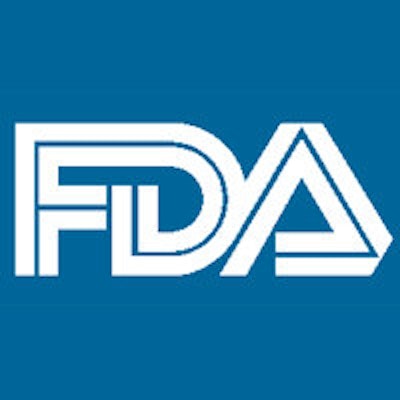
Once again, the U.S. Food and Drug Administration (FDA) is set to embark on an investigation into the safety of gadolinium-based contrast agents (GBCAs), after several recent studies found gadolinium deposits in the brains of some patients years after they had received contrast-enhanced MRI scans.
There's a reason this FDA action may feel like déjà vu. Eight years ago, the FDA mandated that all gadolinium contrast manufacturers add a black box warning regarding the risk of nephrogenic systemic fibrosis (NSF) for patients with acute or chronic insufficient renal function.
That mandate had the desired effect, as the FDA warning and changes in clinical imaging protocols led to a dramatic decline in NSF incidents in the following years. Now, the agency wants to determine the effect, if any, of leftover traces of gadolinium in the brain.
Possible safety risks
The new initiative affects only gadolinium contrast and does not apply to other types of imaging agents, such as iodine-based contrast or radioisotopes. The blueprint of the investigation has the FDA and its National Center for Toxicological Research (NCTR) looking into any possible safety risks with GBCAs and the issue of gadolinium retention.
The agency has asked manufacturers of gadolinium contrast to "specifically report any safety problems associated with GBCA retention," wrote FDA spokesperson Sarah Peddicord in an email to AuntMinnie.com. Some manufacturers have already initiated animal and clinical studies to see how their products perform, she added. Healthcare providers and imaging facilities are already required to report adverse events to the FDA Adverse Event Reporting System (FAERS).
The FDA's policy is that healthcare professionals should use gadolinium contrast agents only when the additional information provided by contrast is necessary. The agency is advising patients, parents, and caregivers to speak with their provider if they have any questions about the use of GBCAs for MRI scans.
The FDA declined a request by AuntMinnie.com to speak with someone in NCTR about what current or additional information NCTR plans to review; how NCTR will work with GBCA manufacturers to collect their findings; and whether there will be individual recommendations for each gadolinium contrast agent at the end of the evaluation.
It "is premature to address these questions, as the NCTR study is currently being developed," Peddicord said.
As for a timeline on the conclusion of the investigation, the FDA "will update the public when more information is available," she said. "At this time, the FDA is not requiring manufacturers to make changes to the labels of GBCA products."
Investigation questions
MRI safety advocate Dr. Emanuel Kanal said he is pleased to see the FDA addressing the question of gadolinium retention; however, he is concerned about whether the agency's probe will evaluate and provide information on each individual gadolinium contrast product.
 Dr. Emanuel Kanal, director of MR services at UPMC.
Dr. Emanuel Kanal, director of MR services at UPMC.As an example, he noted the FDA's 2007 GBCA mandate requiring all manufacturers to include the black box warning for their agents. At that time, there was almost no mention of the differences between individual GBCA products, despite available research, he asserted.
"For whatever reason, the FDA chose not to mention or notify healthcare providers or the public, and the identical pattern seems evident today," said Kanal, who is director of MR services and a professor of radiology and neuroradiology at University of Pittsburgh Medical Center (UPMC).
Recent peer-review articles have "done a good job of documenting differences among the agents today, but again we don't know if the agents are helpful or harmful," he added.
This year alone, three published studies have raised concerns about gadolinium retention. In May, researchers from Teikyo University in Tokyo found significantly higher levels of gadolinium in the dentate nucleus and globus pallidus regions of the brain in five people who had received gadolinium-based contrast agents, compared with those who had never received GBCAs.
In a related paper, McDonald et al from the Mayo Clinic in Rochester, MN, were unable to explain traces of gadolinium they found in four areas of the brain several years after the administration of MRI contrast.
Finally, Radbruch and colleagues discovered greater signal intensity in the dentate nucleus and globus pallidus of patients who had received gadopentetate dimeglumine (Magnevist, Bayer HealthCare), while there was no such escalation in patients who had received gadoterate meglumine (Dotarem, Guerbet) -- despite the fact that a substantially larger dose of contrast was used in the latter group (Radiology, June 2015, Vol. 275:3, pp. 783-791).
"We are accumulating or retaining residual gadolinium in the brains of patients who have received multiple doses of some but not all of these agents," Kanal said. "And for the ones that we say 'not all,' all we are saying is that we are not able to detect the same effect. It is possible, theoretically, that they are retaining [gadolinium at levels] so small that we cannot detect it using MRI."
Positive research
Kanal and colleagues at UPMC earlier this year reviewed the safety of gadobenate dimeglumine (MultiHance, Bracco Diagnostics) in a study that concluded the number of adverse reactions tracked over 7.5 years was "infinitesimally small."
 Dr. Saeed Fakhran, assistant professor of radiology at UPMC.
Dr. Saeed Fakhran, assistant professor of radiology at UPMC.Lead author Dr. Saeed Fakhran, an assistant professor of radiology, said he welcomes the current FDA probe into the safety profile of gadolinium contrast.
"I'm confident that the results of the FDA investigation will show what most of us already know and believe: That is that [GBCAs] are safe agents," he said. "I think if you look at them individually or in total, it is not going to change the conclusion. You don't like to see gadolinium build up in someone's brain, but no one has actually proven harm."
Fakhran believes that contrast-enhanced imaging is overused in the U.S., "but, at the same time, does it do a lot of good for people who need imaging? Absolutely. I would caution people to not overreact to these observational studies that have not actually proven any harm from these agents."
UPMC, for example, performs a large amount of oncologic imaging, especially brain MRI for metastatic disease.
"Those patients tend to be imaged frequently and need some sort of contrast," Fakhran said. "I would hate for one of these patients to think they should not be getting contrast and they are not being imaged appropriately."
Kanal agreed that healthcare providers have become dependent on GBCAs, which have become "so frighteningly powerful for society."
"I am not concerned about losing these agents, but what is appropriate to be concerned about is, should we be using all of these agents?" he added.
One possible solution is for radiologists to become more involved in the decision-making process of whether or not to administer contrast.
"Every contrast administration given for MRI should require a radiologist's name and signature, specifying what agent to what patient at what dose," Kanal said. "The referring physician has no expertise in that area. The only one in the entire hospital who will be expected to have expertise on the safety of these agents will be the radiologist."


.fFmgij6Hin.png?auto=compress%2Cformat&fit=crop&h=100&q=70&w=100)





.fFmgij6Hin.png?auto=compress%2Cformat&fit=crop&h=167&q=70&w=250)











